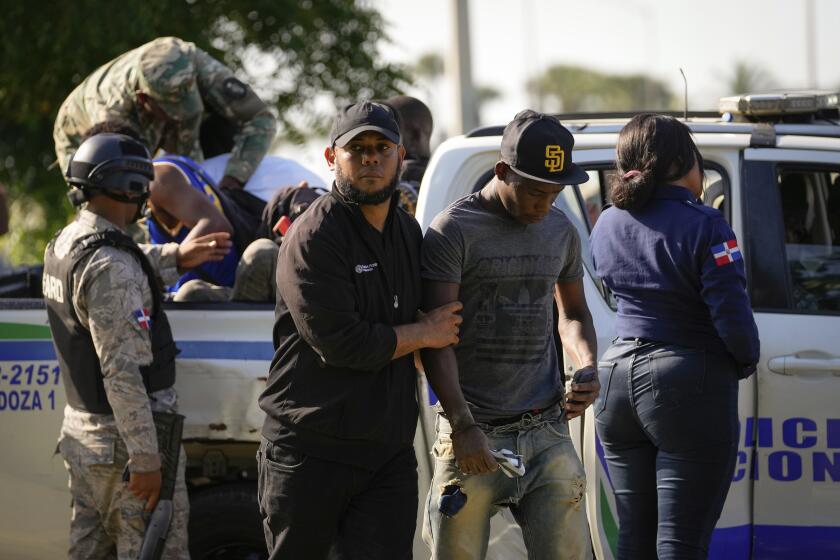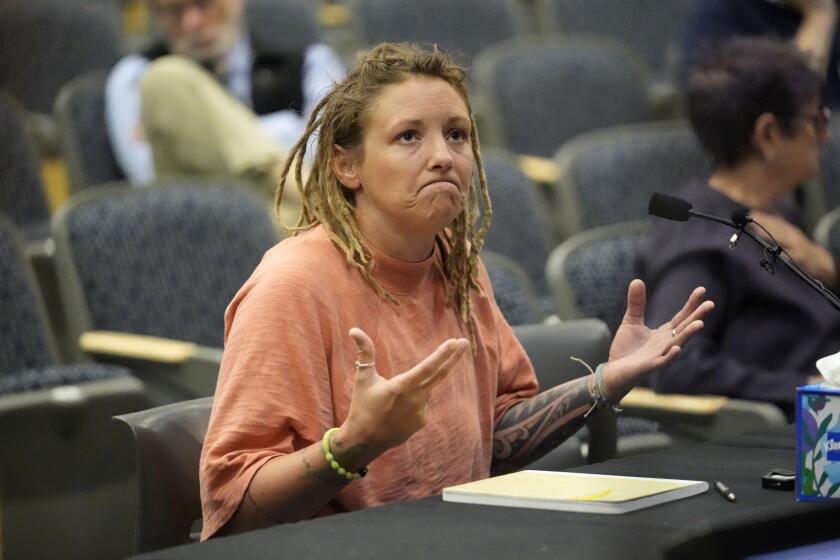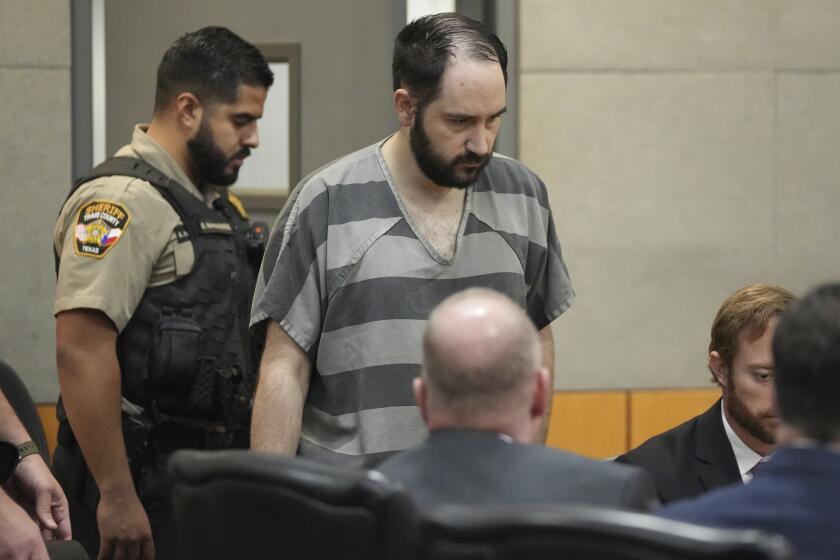Tornadoes’ Death and Destruction
On the morning after, Tammy Pennington was looking for her kitchen.
The rest of her trailer home she had found, more or less. Scraps of the frame were dangling from a tree. Other shards were strewn about a muddy field. She had even tracked down her sofa, her treadmill, her linoleum floor -- or rather, their shredded remains. The kitchen, though, was gone.
Then a neighbor came by and said it had been spotted an eighth of a mile down the road, plunked in a pasture, surrounded by grazing cows and drifting tufts of yellow insulation. One question answered.
Too many more achingly unresolved.
Dazed residents of Tennessee, Alabama and Ohio spent Monday picking through vast piles of rubble, looking for friends, for belongings, for anything familiar after about 70 tornadoes, a few of them extraordinarily powerful, cut a broad swath of wreckage across several states over the weekend.
At least 36 people died in the storms and hundreds were injured. Scores of houses were obliterated, several manufacturing plants were destroyed, uncounted cars and trucks and trailers were lifted, twisted, hurled into the raging funnel clouds that pulverized whole communities.
The band of tornadoes and accompanying thunderstorms stretched from Pennsylvania to Louisiana. They swept across the region in waves, from late Saturday to early Monday, catching victims as they drove home from church, as they huddled in their basements, as they tracked radar images of the violent weather on TV.
The death toll consisted of 17 victims in Tennessee, 12 in Alabama, five in Ohio and one each in Pennsylvania and Mississippi. Scores of people were still unaccounted for late Monday -- though no one could say whether they were buried under homes or simply unable to communicate because of downed phone lines.
“We need the prayers of everyone in the country,” Tennessee Gov. Don Sundquist said.
Touring this devastated mountain community by helicopter on a tauntingly sunny afternoon, Sundquist said the twister that nailed Mossy Grove late Sunday may well have been an F5 -- the most severe classification on the Fujita scale. Such storms can pack winds topping 300 mph, though they account for just 1% of the roughly 1,000 tornadoes that hit the United States each year.
At least seven people were killed here in eastern Tennessee, including 73-year-old Marjie Williams and her son Michael, 47, who lived a few doors apart in homes that the wind ripped to splinters in the roaring confusion of the night.
An exhausted James Williams -- Marjie’s son, Michael’s brother -- searched the wreckage on Monday afternoon, drawing on a Marlboro Light. He set aside papers that looked important. He scavenged the block for his brother’s prized gun collection. “Hard to believe,” he mumbled. “Unreal.” He found an old-fashioned wooden telephone booth his brother had restored. It was about the only intact item in what was left of the house.
“I wish he could have gotten inside this,” James Williams said, staring at the booth. “He might have made it.”
A few hundred miles north, in Van Wert, Ohio, authorities said the funnel clouds that raked the farm country near the Indiana line may have rated F4, with winds up to 260 mph. The storm killed two, demolished at least 26 homes and destroyed several industrial plants, leaving up to 500 workers jobless, said Hugh Saunier of the county Emergency Management Agency.
It could have been a lot worse.
Just moments before the tornado touched down, a quick-thinking manager herded dozens of parents and children out of the movie theater where they were watching “The Santa Clause 2.” The twister ripped the roof off the theater and tossed two cars inside, on the blue-cushioned seats. But the moviegoers, hunkered down in the cinderblock lobby of the theater, survived unscathed.
Similar stories of close calls echoed in the makeshift shelters set up in churches, civic centers and schools in several states.
Many people managed to escape serious injury thanks in part to early-warning sirens. In some places, most notably Van Wert, alarms began sounding up to half an hour before the worst winds hit.
“We’re doing much better at forecasting and warning,” said Chuck Doswell, a tornado expert with the National Severe Storms Laboratory in Norman, Okla. He recalled a similar band of storms stretching from Canada to the Gulf of Mexico in April 1974 -- a system that killed 10 times as many people. In May 1999, another swarm of 70-plus tornadoes -- including some rated F5 -- killed 50 people in Oklahoma and Kansas.
“We have reduced the death toll from tornadoes considerably,” Doswell said.
This weekend’s fierce weather can be blamed, Doswell said, on the “cliche of clashing air masses.” The weather was unseasonably warm in much of the Midwest and South -- up to 80 degrees and humid. But cold air rushing down from Canada in the upper atmosphere created instability. The inevitable clash set up powerful, whirling storms that dropped golf ball-sized hail on some towns and funnel clouds on others.
Though the traditional tornado season is spring, meteorologists said autumn twisters are fairly common across the South and Midwest.
Still, at least here in eastern Tennessee, no one seemed prepared for the scene they awoke to.
Teddy bears and front doors were tossed helter-skelter across fields. A lawn mower hung from a tree. Several houses were peeled open, as if a giant can opener had popped off their front facades. The closet was open in one exposed bedroom, revealing a neat row of hanging clothes, none of it so much as wrinkled. Fluffy bits of pink and yellow insulation were snagged on bushes all over town -- an oddly cheery sight in the bleak landscape.
Sunday night had been a roaring, vibrating chaos of clunks and rips and screams. “Find my babies!” one woman had wailed as the winds died down, her voice echoing through the shattered streets.
Monday morning, the sounds were more orderly, more predictable -- but still heartbreaking.
Kevin Freels, a 31-year-old machinist, picked his way over the punched-in walls of his house, pointing out his computer room, his living room, his carport -- none of them recognizable to anyone but him. His face was cut, his knee was bruised and his house was destroyed, but he pronounced himself grateful.
Freels had pushed his mother, wife and 9-year-old daughter into the bathtub as the storm screeched toward them -- a trick he remembered hearing on the Discovery Channel. There was no room for him, so he crouched beside the tub. Then the lights went out. Rain drenched his clothes. His ears filled up with mud. He came to, with a start, and realized at once that his home had collapsed all around him. But a few yards away, he heard his wife and daughter and mother shouting from the bathtub -- amazingly, exultantly, alive.
“We should not have made it, but we did,” Freels said, his voice still shaky. His daughter, Lindsay, picked one of her old beauty pageant trophies out of the rubble.
“This would make a believer out of you,” Freels said.
*
Ellingwood reported from Mossy Grove, Simon from St. Louis.
More to Read
Start your day right
Sign up for Essential California for news, features and recommendations from the L.A. Times and beyond in your inbox six days a week.
You may occasionally receive promotional content from the Los Angeles Times.






